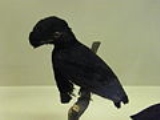
Long-wattled Umbrellabird
Encyclopedia
The Long-wattled Umbrellabird, Cephalopterus penduliger, is a bird found in the humid forests of the Chocó of western Colombia
and Ecuador
. It is sensitive to habitat destruction
, and its large size make it easy to hunt. Furthermore, only a few of the populations live within protected areas, so the bird is now considered vulnerable
.
The bird's common name
comes from the a long, inflatable wattle
on the neck of the male, which is up to 35 cm long and covered in short, scaly feathers. The females, by contrast, have a reduced wattle and are only about half the size of the males.
Their diet is of insects and fruit. Their nest was first seen by scientists in 2003. In breeding season, the males shout a loud call.
Colombia
Colombia, officially the Republic of Colombia , is a unitary constitutional republic comprising thirty-two departments. The country is located in northwestern South America, bordered to the east by Venezuela and Brazil; to the south by Ecuador and Peru; to the north by the Caribbean Sea; to the...
and Ecuador
Ecuador
Ecuador , officially the Republic of Ecuador is a representative democratic republic in South America, bordered by Colombia on the north, Peru on the east and south, and by the Pacific Ocean to the west. It is one of only two countries in South America, along with Chile, that do not have a border...
. It is sensitive to habitat destruction
Habitat destruction
Habitat destruction is the process in which natural habitat is rendered functionally unable to support the species present. In this process, the organisms that previously used the site are displaced or destroyed, reducing biodiversity. Habitat destruction by human activity mainly for the purpose of...
, and its large size make it easy to hunt. Furthermore, only a few of the populations live within protected areas, so the bird is now considered vulnerable
Vulnerable species
On 30 January 2010, the IUCN Red List of Threatened Species identified 9694 Vulnerable species, subspecies and varieties, stocks and sub-populations.-References:...
.
The bird's common name
Common name
A common name of a taxon or organism is a name in general use within a community; it is often contrasted with the scientific name for the same organism...
comes from the a long, inflatable wattle
Wattle (anatomy)
A wattle is a fleshy dewlap or caruncle hanging from various parts of the head or neck in several groups of birds, goats and other animals. In some birds the caruncle is erectile tissue.The wattle is frequently an organ of sexual dimorphism...
on the neck of the male, which is up to 35 cm long and covered in short, scaly feathers. The females, by contrast, have a reduced wattle and are only about half the size of the males.
Their diet is of insects and fruit. Their nest was first seen by scientists in 2003. In breeding season, the males shout a loud call.
Further reading
- Snow, D.W. (1982). The Cotingas: Bellbirds, Umbrella birds and their allies. British Museum Press. ISBN 0-19-858511-X

